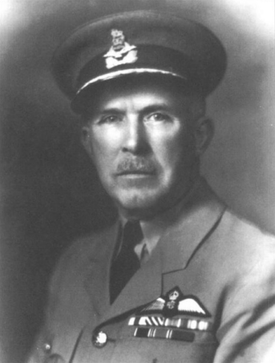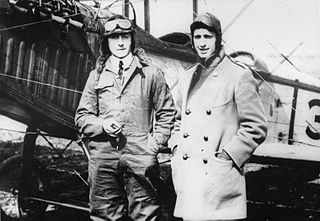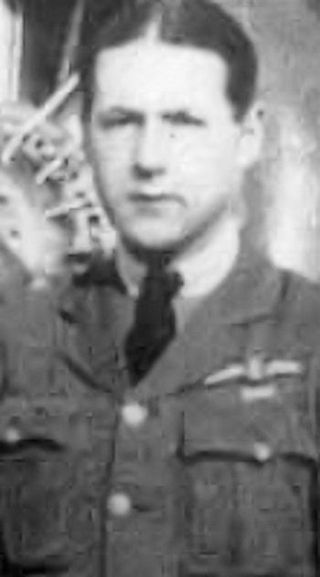Related Research Articles

William George Barker, was a Canadian First World War fighter ace and Victoria Cross recipient. He is the most decorated serviceman in the history of Canada.
Lieutenant Gerald Alfred Birks was a Canadian First World War fighter ace credited with twelve aerial victories while serving in the British Royal Flying Corps and Royal Air Force.

Francis Granger Quigley, was a Canadian aviator and flying ace of the First World War, who was credited with 33 aerial victories. He was notable for scoring the majority of his victories against German fighter planes.

Air Vice-Marshal Albert Earl "Steve" Godfrey MC was a Canadian First World War flying ace, officially credited with 14 victories while flying for the Royal Flying Corps. He spent the remainder of his career in the Royal Canadian Air Force.
Captain Thomas Frederic Williams MC was a Canadian First World War flying ace, officially credited with 14 victories.

Captain Ernest Charles Hoy DFC was a Canadian First World War flying ace, officially credited with 13 victories. He later pioneered airmail flight over the Canadian Rockies.
Lieutenant Harold Byrn Hudson MC was a Canadian First World War flying ace, officially credited with 13 victories. As wingman to William George Barker, he scored a record five victories over observation balloons in a single day.
Lieutenant Harold Arthur Sydney Molyneux was a World War I flying ace credited with five aerial victories. During World War II, he returned to service in the Royal Canadian Air Force.
Lieutenant Henry Coyle Rath DFC was a Canadian World War I flying ace credited with twelve aerial victories.
Captain Guy Borthwick Moore (1895–1918) was a Canadian World War I flying ace credited with ten aerial victories.
Captain David MacKay McGoun was a Canadian World War I flying ace credited with nine aerial victories.
Captain Frank Clifton Gorringe was a British World War I flying ace credited with 14 aerial victories.

Lieutenant Kenneth Russell Unger was an American World War I flying ace credited with fourteen aerial victories. His candidacy rejected by his own nation, Unger applied to the British Royal Flying Corps for military pilot training in June 1917. Once trained, he was assigned to the Royal Naval Air Service (RNAS). As the RNAS was merged into the Royal Air Force, Unger scored his aerial victories between 26 June and 1 November 1918. In later life, Unger remained involved in aviation and served again during World War II. He also joined the U.S. Navy Reserves, rising to the rank of rear admiral.
Captain Stanley Stanger was a World War I flying ace credited with 13 confirmed aerial victories scored on the Italian Front. He was also noted for his ingenious escape from being captured by the Austro-Hungarians.
Captain James Hart Mitchell was an English World War I flying ace credited with 11 aerial victories. He was seconded to the Royal Flying Corps during the war; he returned to his home regiment afterwards.
Lieutenant William Henry Brown was a Canadian World War I flying ace credited with nine aerial victories.
Captain Conway MacAllister Gray Farrell was a Canadian flying ace during World War I. He was credited with seven aerial victories.
Captain William Carrall Hilborn was a World War I Canadian flying ace. He was raised as a western Canadian pioneer. He undertook his own aviation education in his eagerness to join the Royal Flying Corps. He overcame physical problems and a tendency toward airsickness to become a wingman to famed Canadian ace William George Barker. After scoring seven victories in Italy, Hilborn died on 26 August 1918, of injuries received in a flying accident.
Lieutenant Malcolm Plaw MacLeod (1897-1960) was a Canadian flying ace. He was credited with seven aerial victories scored during the closing days of World War I. He then returned to Canada to complete his education and work as a stockbroker until World War II, when he served in the Royal Canadian Air Force for the war's duration.
Squadron Leader Roy Kirkwood McConnell was a World War I flying ace from Canada credited with seven aerial victories. His award of the Distinguished Flying Cross noted both aerial victories, as well as gallantry in hazardous ground attack missions.
References
- Above the Trenches: A Complete Record of the Fighter Aces and Units of the British Empire Air Forces 1915-1920. Christopher F. Shores, Norman L. R. Franks, Russell Guest. Grub Street, 1990. ISBN 0-948817-19-4, ISBN 978-0-948817-19-9.
- William Barker, VC: The Life, Death and Legend of Canada's Most Decorated War Hero. Wayne Ralph. John Wiley and Sons, 2007. ISBN 0-470-83967-8, ISBN 978-0-470-83967-6.
- 1 2 "Lieutenant William Myron MacDonald". Canadian Great War Project. Retrieved 15 December 2011.
- 1 2 "William MacDonald". theaerodrome.com.
- 1 2 3 Above the Trenches, p. 247.
- ↑ William Barker, VC, p. 105.
- ↑ Supplement to the London Gazette, 2 November 1918, p. 12969. Retrieved 15 December 2011.
- ↑ The London Gazette, 6 January 1920, p. 201. Retrieved 15 December 2011.